For the few that do not know who Faile are and what Faile do, can you give a quick description of your work??
Yes, Faile is a collaboration between Patrick Miller and myself, Patrick McNeil, and our partnership has been going strong for over 20 years. Oh, and we make art.
Many kinds of art… You two have been street artists, gallery artists, museum artists, collage artists, sculptors… you’ve even been video game designers! Did I miss anything?
I don’t think so! We like to play with a lot of different materials and mediums. If you look at the breadth of our work, like you said, there is quite a lot of exploration within the practice. I feel like we have our own identity and our own brand and that’s what we’re generally recognized for. That being said, we definitely like to try and push outside of those parameters and try different things.
To me the quintessential example of Faile’s “style” is the print you released for the NYC Ballet. I believe it was 36 colors hand pulled to look like a patchwork?
It was a 28 color silkscreen print but felt like a lot but the end of printing! Yes, the patchwork motif comes from a mix I guess between children’s puzzle block sets, and also a deep inspiration from quilt making. Generally, a big part of our work is piecing together and remixing of found things.
I guess this would be a good time to ask you where these type of influences came form? Where these quilt and children block styles something that both of you grew up with? Or studied extensively? Can you pinpoint how all these influences came to meld together into Faile?
That’s a a good question! I was actually just thinking about this the other day, and just about how important process is to the work that we do. You know, a lot of these things are about coming into work Monday through Friday and putting in the hours and just making and finding things along the way. And these things just start to reveal themselves. I think with the patchwork stuff there’s some parallels to what happen on the street when you’re putting up posters, or you look around at advertising and how these things kind of juxtaposed and get put together on the street, I think some of that kind of fell into play when we were looking at some quilt making in particular Gee’s Bend quilts. I remember I was watching an episode of Antiques Roadshow one night and they were talking about quilt making and how there was a group of quilt makers in this area called Gee’s Bend, they were talking about these beautiful quilts that they made, and they were a kind of minimalist art. They took all these bits and pieces of leftover denim, or old sheets and kind of repurposed them into these beautiful quilts. These quilts even influenced minimalist painting in the 1950s. And I was just thinking about how my friend had this quilt that his mom made him that was this mosaic of rock and roll stuff. She took all his old heavy metal t-shirts and made it into a t-shirt quilt for him. And there was just some weird chemistry that happened there.
I was hearing about the quilts, and thinking about the quilts, and thinking about working on the street with layers of posters and grids, and thinking about collage, and just how these things kind of work together… and it just started. It started kind of a whole new process in the studio working on wood with these wood paintings. And this is a reference point in our history separating our style of work before and after. And that stuff started kind of with our works right around 2000, and later we began working with apple boxes in the same manor. And those were kind of inspired by Andy Warhol’s Brillo Box stacks.
We found an apple box on the street outside the studio and we treated it as a canvas. And that resulted in us talking about piling them up as boxes to create a similar patchwork effect, and what happened was that when we were making them, we’d make like 80 of them, and we’d stack them against the wall as we were finishing them, and as we stack them in these neat rows, it started to make this book casing effect. And we thought it would be really cool if we cut the faces off of these and started making these more modular pieces, and at the same time, we were also working on these puzzle block sets and they all worked on a ratio of like two inches. So when we put the block pieces together for the first time and there were gaps, we started filling them in with two inch cubes. And that kind of that snowballed into like a crazy process that is still going on today. We’ve been working on the woodblock paintings now for about 12 years or so.
In my opinion, they’re beautiful & brilliant. When I was at your studio years ago I was in love with this piece of a ballerina painted on all 2 inch wood blocks presented as a mosaic of sorts. But before all that you guys started out as a stencil artist, right? Or were you originally a graphic designer?
Yes, originally we were doing small stencils in the beginning. And that translated well, but we kind chilled on the stencils after a bit and focused primarily on posters just because you could get more up quickly with the posters than you could the stencils. So we started messing with that. But then when we would travel, we would run out of posters. And so we started making some of the posters into stencils so that while we were traveling we could continue to put up the poster images with stencils.
And then there was a weird thing at that time in New York with like this kind of paper versus paint rivalry thing going on. We would put up posters and be referred to as “paper people” or whatever, and you get dissed by graffiti writers because you were working with paper. So to release some of that tension I would start to stencil the images. I guess the criticism dictated this switch, and it just shows that you could do street art in multiple mediums, and it didn’t really matter which you chose, they could all be effective.
So to back up a bit, you and Patrick met originally in in college?
We actually met in high school when we were fourteen. This was in Arizona, I had just moved from Alberta, Canada. We actually met the first day because we had the same first name and they kept calling attendance and kept calling his name. But because my name wasn’t on the attendance yet and my last name is McNeil and his is Miller, every time they went to call Miller I started to raise my hand thinking they were going to call my name. Eventually, we were in gym class together and they called his name and this time I was sitting next to him and I was like, “Oh, hey! I just moved here from Canada and my name is also Patrick” and we just hit it off! We had art classes all through high school together and just shared a passion for art and swapped sketchbooks and developed a friendship through art.
After high school we studied fine art together our first year in college. And then I moved off to study abroad in England. And that’s kind of where I got introduced to stenciling for the first time in Brighton. Particularly, there were a lot of punk flyers and stuff like that and promotions for bands and stuff done on the street with stencils. I just found that really beautiful. This inspired me when I returned home to figure out how to do stenciling on my own.
I ended up moving to New York shortly after England and studying graphic design there and Miller ended up going to Minneapolis College of Art and Design to study graphic design there. Despite this, all through college we stayed in touch, we would talk about all the courses and classes that we were taking, all the new techniques we were learning… we were truly best friends!
Eventually, we both discovered silk screening in college, and I would go out to MCAD on a spring break and silkscreened in their studios with him. MCAD had 24 Hour access and free ink at the time so we would just go mad printing there. And then he would come up to New York whenever possible and silkscreen here. This is when I started noticing what was being put on the streets of New York at the time. This was 1998 and I was actually working down on Canal Street by Pearl Paint, and I just walked around there during lunches and stuff and noticed every week how the streets would change and notice the graffiti, and street art, and things that were happening all over. I was really excited by it and just loved to watch how the art formed. I loved that one day it was there the next day was it was gone. I liked how the weather affected it. I liked how people interacted with it. And it didn’t seem like there was a lot of people doing it at the time, and I was just super excited to participate in it.
So you saw this budding scene entitled street art, who was influencing you in NYC at this point?.
The people that I noticed at that time were BAST, Shepard Fairey and W.K. Interact. They were like the three main ones at this point. And then there was another artist from Sweden that came over AKAYism. But, I was also realizing, there weren’t many artists at the time that were doing it globally, there were only maybe five that would do Tokyo, New York, Europe and just go for it. The internet was still pretty young and sharing was limited to peoples photo books and a few small magazines, so it was still very new and I felt like an insider and it was a very small culture.
So that inspired us to start going over to England with whatever money we could save up and stay with friends, and just go out and put stuff up all night long for a week and then come back and then try and do it in other cities. Thats kind of how it started. We just went gangbusters with it for about five years, just doing it illegally and scraping by, and doing whatever we could to not have to go get a real job, and just continue being full time artists. I guess we just got kind of lucky along the way and have been able to manage a career out of it.
You guys have built a very large cabinet of unique intellectual property full of original imagery, Did you sample or borrow images or were you always striving to create new “original” works?.
I mean, it’s a lot like remixing. You think about old Tribe Called Quest or old Digable Planets records, honestly a lot of early Hip-Hop and Techno. A lot of these artists sampled multiple old songs and would mix them together and make new original soundscapes. And I think that’s kind of in-line with how we make our images, by grabbing or sampling things from the past. And then remixing them to make new contexts and new stories for them.
Exactly, you guys are not really known for using stuff like Mickey Mouse as your main source material.
Yeah. we generally stay away from that. But there is an exception to every rule, such as this new set of paintings we did for a show in Paris earlier this year. This was the first time we’ve thrown Mickey Mouse into something of ours. But it was more of a comment on like the appropriation of brand as a spectacle.
It’s funny because I have a BAST Mickey Mouse print in my living room I LOVE! I know you have worked with BAST many times over the years including your crazy immersive show at the Brooklyn Museum. Was he one of the first people to help, or teach you guys how to paste and stencil on the streets?
No, there was nobody directly teaching us. You would kind of teach yourself just through observing what was going on in the street and deciding, do I want to do spray paint? Do I want to put up a poster? The teaching we received was more like what kind of glue and brush to use to put up your posters. W.K. Interact in particular was really helpful with things like recommending glue and stuff. It’s funny because every artist has their own brush. I remember Shepherd used a particular type of brush that was different than the ones used by everyone else that was hard to work with but he was masterful with it.
At this time I was also learning about graffiti culture and etiquette. I wasn’t really familiar these rituals because I didn’t grow up with graffiti culture. In St. Albert, Alberta, there wasn’t a lot of graffiti growing up! So that wasn’t until I moved to New York that I had to get a better understanding of where, when, and how I could place our art. Fortunately, we never ran into any problems covering up others work, or starting any beef with other crews. I guess I kinda lucked out with some of the spots I chose.
So back in the day, was it mostly lower Manhattan? Was it like you got off work and went stenciling and pasting all night all over the five boroughs?
I mean, we were very fortunately, we sold enough bits to scrape by without a day job. We were doing exhibitions by the time we graduated college. I had friends at that time that were in advertising and stuff and I studied graphic design and could of gone that route, but they just all seemed pretty miserable in their workplace. And I thought to myself, I just will do whatever I can do to not end up in an ad agency or some other job that I really didn’t want. All I wanted to do was street art.
Was there any moment when you were like wow we really finally “made it”?
I remember being in England and walking across the bridge to the Tate Modern and talking with Pat being like, “wouldn’t it one day be awesome to do something with the Tate Modern and maybe have a piece shown there?” And then literally the next year, we were invited to paint the outside of the Tate Modern with six other artists. Being up there it was just so surreal. Maybe that was a feeling of having “made it.” But you’re always striving and setting new goals while hopefully still appreciating what you’ve accomplished. It’s a tricky balance to obtain as a creative.
Any memorable times you got in trouble on the streets, or felt like you were far from “made”?
I can’t remember any of them being particular interesting or memorable. But we did get robed at knife point once in England, and arrested at gunpoint in Berlin when out painting. But they are not stories I care to reminisce on.
So Faile is always doing something, I’m sure you had lots of stuff cancelled or moved around because of COVID?
We just had a solo show in Paris Called “Off The Walls” that show came down about a month ago now. But the main thing that we had planned this year was the opening of new club here in New York. But, yeah, that’s all been pushed back for obvious reasons.
So tell me about the show you just did in Paris. Most of the works in this show although distinctly Faile, are somewhat of a departure from you “classic” style?
Yes, they’re a series of paintings on canvas. They reference a lot more of the earlier printmaking stuff that we did on paper from back in college. But they also reference a lot of classical painters like Matisse and Picasso. It’s a weird hybrid kind of thing.
But they still somewhat contain lots of your trademark characters like the “Scuba Horse” & “Faile Dog”, but are still very refreshing and new.
Thank you! We try and throw a couple anchors in there just so that it connects back to our history, and not go too far off of the cliff, which we tend to do once in a while. Here it felt like part of the story of things within our world.
A lot of this body of work references the process that we see on the street, the idea of observation, how do we observe these things not only directly, but additionally through our phones and computers. If you think about how you open up your computer and you have all these different windows open and how these windows overlap on your computer, or if I hold my phone up to a wall and I’m looking at it through my phone and then that phone is layered over top the that wall, and I’m seeing it all together. It’s these ideas of perception, and grids, and weird abstractions that happen through how we perceive things through digital media.
Now that you point that out I can see how some of it is reminiscent of an actual wall, with multiple pieces, ads, tags, etc. are all living symbiotically.
Exactly, and additionally if you look at still life paintings like Matisse’s or Picasso’s we were kind of playing a little bit of some of these historical paintings. And referencing what a still life might have looked like back then compared to now and the windows we see the world through.
We started this series before Covid and wanted to take a break from wood for a show and there were a lot of things that we were looking at and just curious about, like how brand and nostalgia plays into art, like Gucci or Disney. Obviously we all experience brands as a part of our lives but there are so many Disney and Star Wars tropes, and these are injected into contemporary art so often. We tried to reshape some of this by using these elements as props and objects in the paintings as traditional still life paintings will do. That sort of mixed with digital objects, pictures of pictures and a sense of layering. Maybe best embodied by city streets and the play between wall surface and physical objects that live against them.
Why still life now? How did these still life themed paintings suddenly become more relevant for you?
I think there’s always a dialogue going between Patrick and I. Usually it comes down to a few points of inspiration for both of us – an “I’ve been thinking about this” or “hey, look at this thing I just made.” As we travel we’re always documenting things. We were both thinking about landscapes in a way along with surface and objects – digital and physical. From there I started working on a few painting tests and Miller was working on some digital tests and all these elements started to come together. The question remained of how we see the world through all these floating windows was there, few had this photo of a wall surface with our shadow taking the picture and it really became poignant to how we see ourselves projected into these worlds. Observing and collecting. They all come together to create something new. In that we found our narratives. We that line between traditional still life and digital still life and how we make sense of that visually.
Plus you incorporated references to Canada, Black Lives Matter, potheads etc…
Yes thats right! It was important to be able to speak to events and ideas in the work that were happening in the moment.
You still have the Faile dog and other classic elements, but it’s definitely in a different context than your earlier works. You used Kurt Cobain and some of The Clash, and Pete Rose, it’s more subtle use of your original elements and a more pop culture theme brought to the forefront.
There all the things that have inspired us along the way. For instance, WWF wrestling cards, or Garbage Pail Kids, and baseball cards, and all that nostalgia that we grew up with collecting that got us excited about art. Because, like I said, growing up in Canada, at least where I was in Edmonton, it was like the Natural History Museum or nothing. You didn’t go there and look at Warhols or graffiti. There wasn’t that kind of contemporary art to go explore and get excited about. All the contemporary art that excited us was wrapped up in skateboarding, and you know, all the the good stuff we collected as kids. So looking at these paintings, again, it’s a lot about nostalgia, and the things that we grew up with that inspired us along the way injected into this body of work.
All of us I think are sentimental these days with COVID and such drastic changes in our overall culture and society. There is this great hole we seem to want to satisfy with “The Good Old Days”. Did this loose logic enter your creative process at all?
Kind of, but it’s always weird because there’s two of us, right? So Miller has his total take on our work, which is totally different than my take a lot of the time. So I have my reasons in these pieces for things that I included and Pat has his own personal reasons for his choices. So it’s kind of like a hybrid thing. It’s always difficult to talk about the paintings from one specific point of view. Obviously there’s discussion along the way about what we’re both thinking because ultimately is a collaboration, but we also have our own personals intentions at times as well.
This kind of develops because we have two separate spaces. Miller’s tends to work more digitally. So he’s on the computer a lot more than I am. I’m usually on the floor of the studio, doing more of the painting side of things. A good way to describe our roles is I’m more analog and Miller is more digital. But we float between each other’s worlds and we go back and forth on everything. Not to say he’s a bad painter, he’s an absolutely amazing painter, he just tends to love being on the computer.
I think he just wears nicer clothes than you and doesn’t want to get paint on them?
LOL, you may be right he usually dresser quite dapper!
All Text Copyright 2020 Matthew A. Eller. Photo’s Copyright 2020 Matthew A. Eller as watermarked. Follow me on Instagram @elleresqphoto.




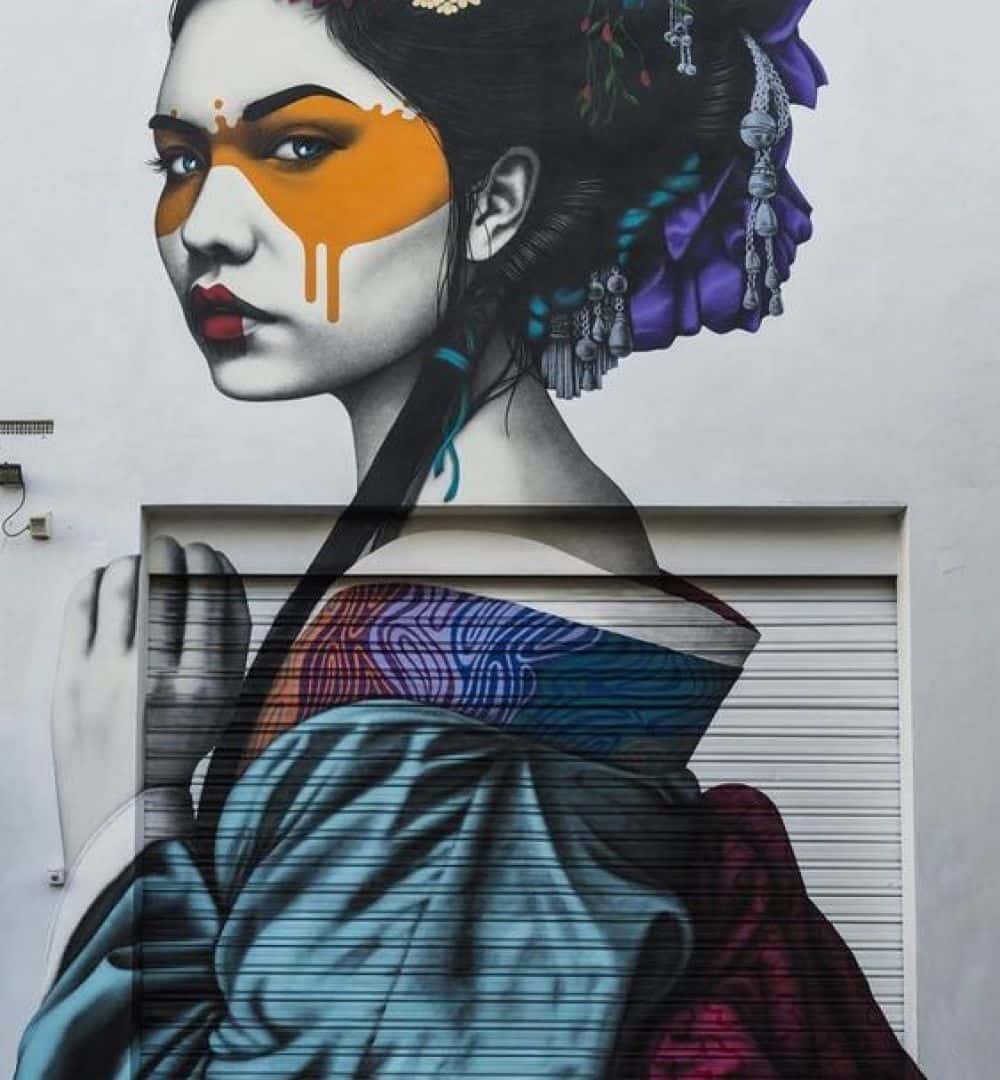














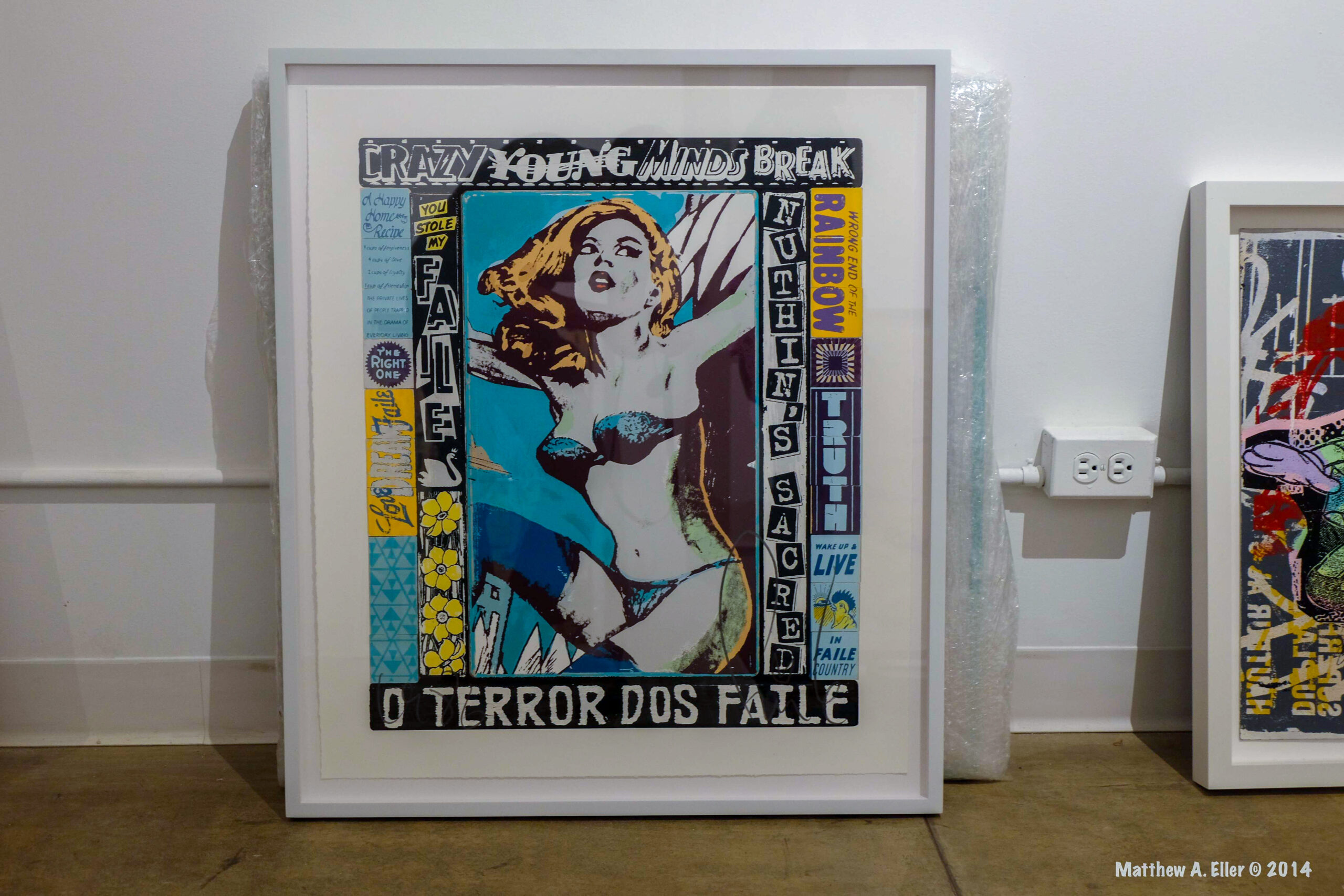


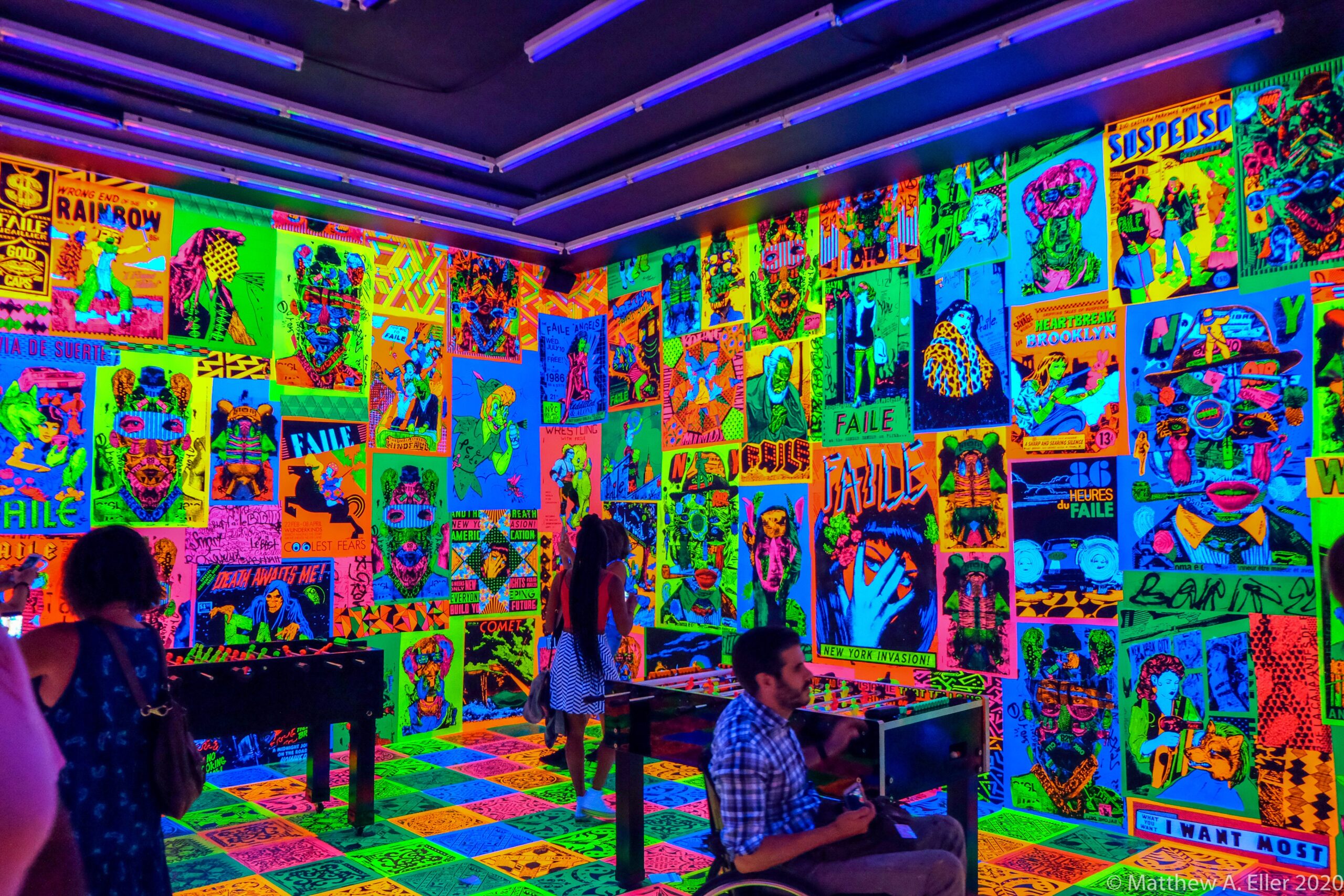














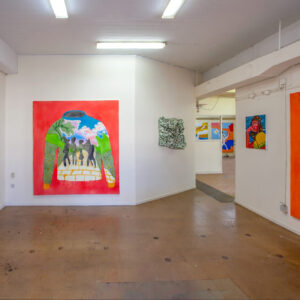
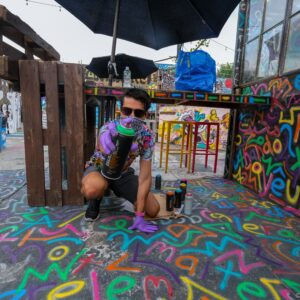






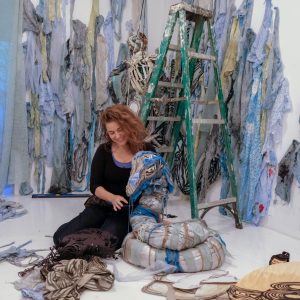




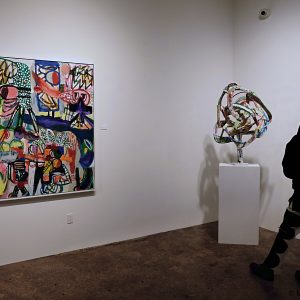
comment